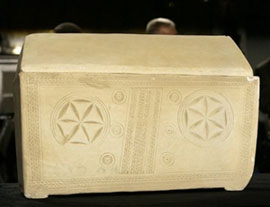


A limestone ossurary found more than 25 years ago in a 2,000 year-old tomb in Jerusalem, that may have held the remains of Mary Magdalene, is displayed to the media during a news conference in New York, Monday, Feb. 26, 2007.[AP]
NEW YORK - Filmmakers and researchers on Monday unveiled two ancient stone boxes they said may have once contained the remains of Jesus and Mary Magdalene, but several scholars derided the claims made in a new documentary as unfounded and contradictory to basic Christian beliefs.
"The Lost Tomb of Jesus," produced by Oscar-winning director James Cameron and scheduled to air March 4 on the Discovery Channel, argues that 10 small caskets, called ossuaries, discovered in 1980 in a Jerusalem suburb may have held the bones of Jesus and his family.
One of the caskets even bears the title, "Judah, son of Jesus," hinting that Jesus may have had a son, according to the film. The claim that Jesus even had an ossuary contradicts the Christian belief that he was resurrected and ascended to heaven.
A panel of scholars that joined the filmmakers Monday at the New York Public Library addressed that criticism and others.
James Tabor, a professor of religious studies at the University of North Carolina at Charlotte, said that while literal interpreters of the Bible say Jesus' physical body rose from the dead, "one might affirm resurrection in a more spiritual way in which the husk of the body is left behind."
But Albert Mohler, president of the Southern Baptist Theological Seminary, said Christianity "has always understood the physical resurrection of Christ to be at the very center of the faith."
Cameron, who won an Academy Award for directing "Titanic," said he was excited to be associated with the Jesus film, which was directed by Toronto filmmaker Simcha Jacobovici.
"We don't have any physical record of Jesus' existence," he said. "So what this film ... shows is for the first time tangible, physical, archaeological and in some cases forensic evidence."
He said that to a layman's eye "it seemed pretty darn compelling."
Jacobovici said that a name on one of the ossuaries — "Mariamene" — offers evidence that the tomb is that of Jesus and his family. In early Christian texts, "Mariamene" is the name of Mary Magdalene, he said.
Most Christians believe Jesus' body spent three days at the site of the Church of the Holy Sepulcher in Jerusalem's Old City. The burial site identified in Cameron's documentary is in a southern Jerusalem neighborhood nowhere near the church.
In 1996, when the British Broadcasting Corp. aired a short documentary on the same subject, archaeologists challenged the claims. Amos Kloner, the first archaeologist to examine the site, said the idea fails to hold up by archaeological standards but makes for profitable television.
"They just want to get money for it," Kloner said.
The film's claims have raised the ire of Christian leaders in the Holy Land.
Stephen Pfann, a biblical scholar at the University of the Holy Land in Jerusalem who was interviewed in the documentary, said the film's hypothesis holds little weight.
"I don't think that Christians are going to buy into this," Pfann said. "But skeptics, in general, would like to see something that pokes holes into the story that so many people hold dear."
Jacobovici said the ossuaries did not initially seem extraordinary because the names on them were all common.
But the filmmakers had statisticians calculate the likelihood that any other family in first-century Jerusalem would have had that cluster of names.
"The numbers range from 1 in 100 to 1 in 1,000 that there is some other family," said Andrey Feuerverger, a professor of mathematics at the University of Toronto.
Osnat Goaz, a spokeswoman for the Israeli government agency responsible for archaeology, said the Antiquities Authority agreed to send two ossuaries to New York, where they were displayed at Monday's news conference, "but it doesn't mean that we agree with" the filmmakers.
The ossuaries do not contain any bones. The bones were reburied after their discovery, as is standard practice with archaeological finds in Israel.
But Jacobovici said DNA evidence can nonetheless be collected from the boxes. He said DNA analysis has so far proved that Jesus and Mariamene, the putative Mary Magdalene, were not siblings and therefore could have been husband and wife.